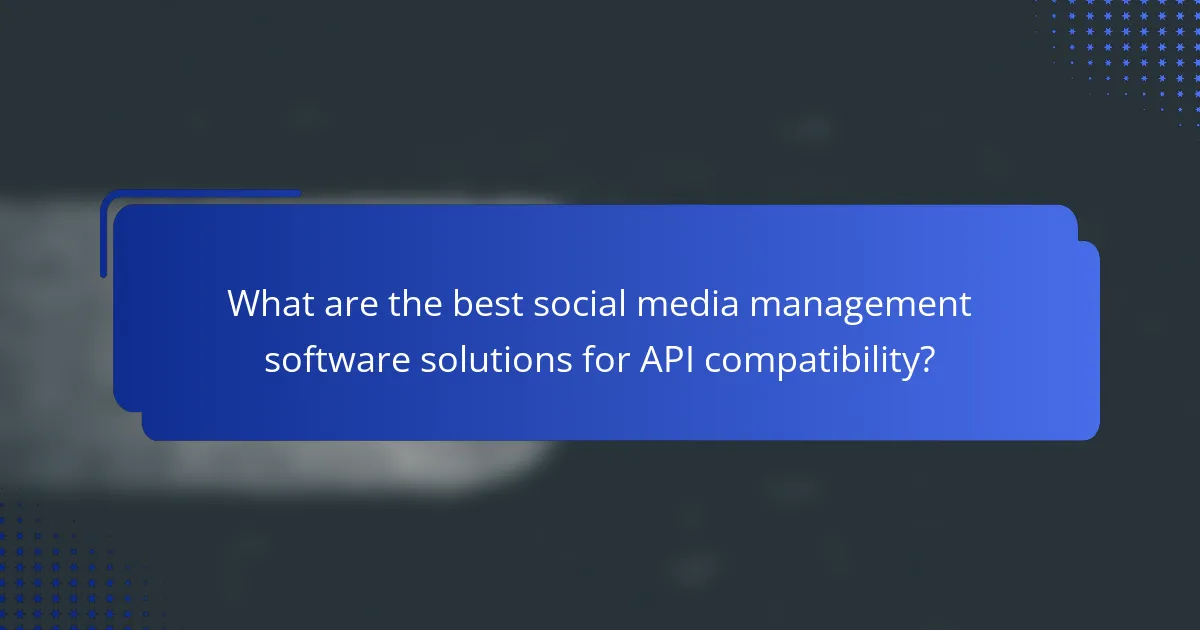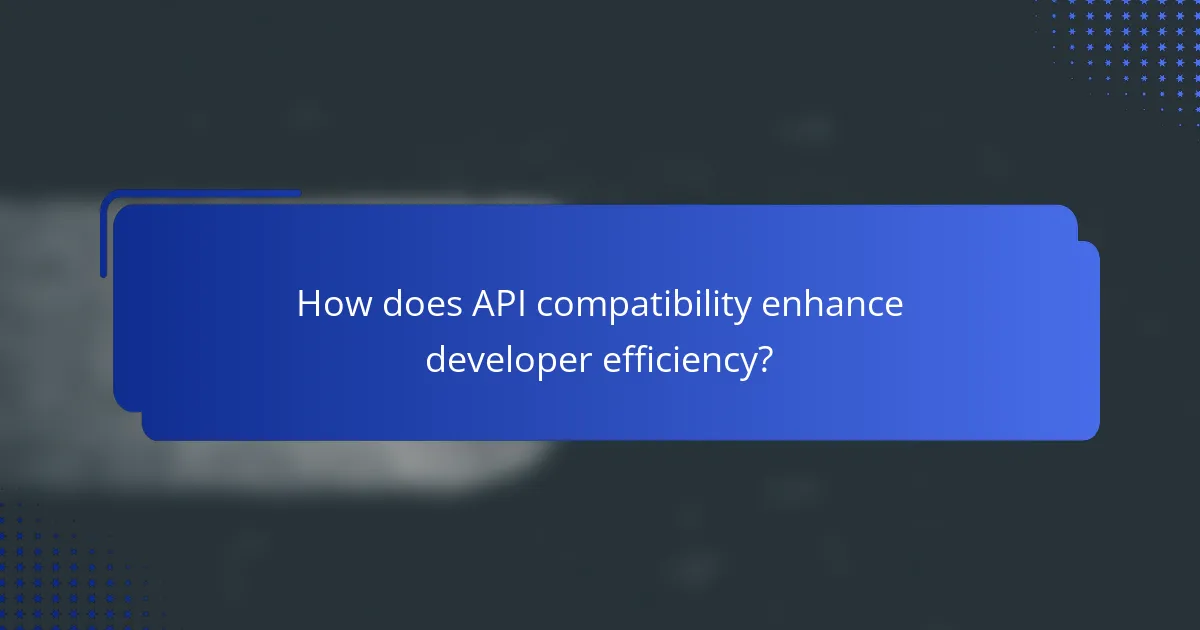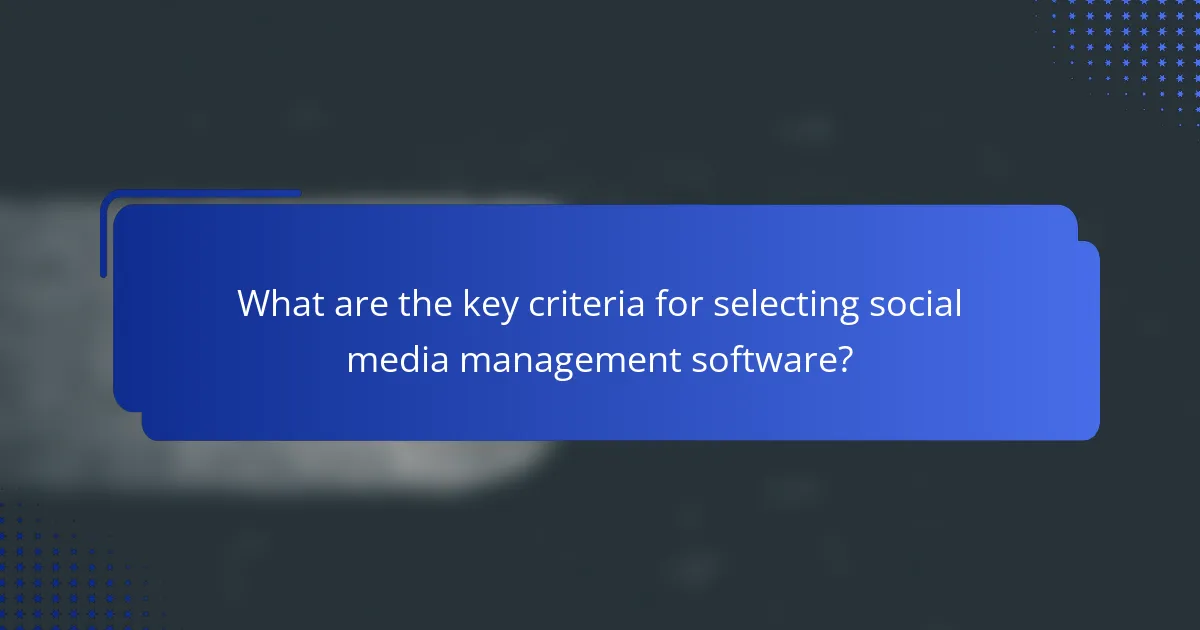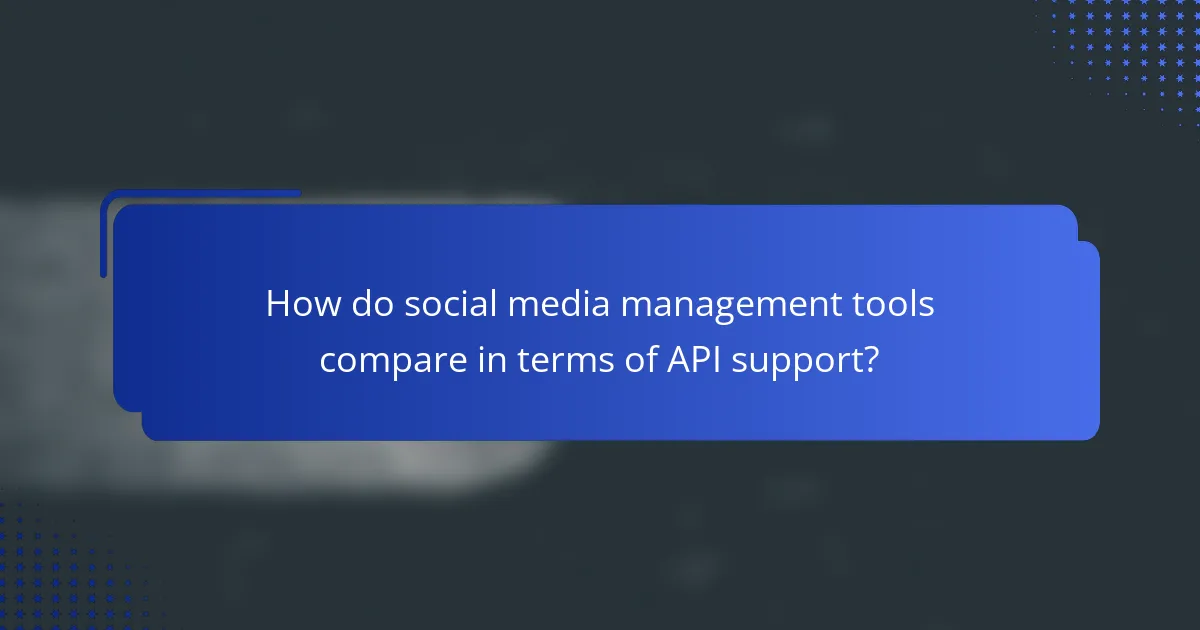In today’s digital landscape, social media management software with strong API compatibility is essential for developers seeking seamless integration and automation. These platforms not only enhance developer efficiency by simplifying data access and task automation but also offer extensive customization options to tailor functionalities to specific needs. By leveraging these capabilities, users can significantly improve their engagement strategies across various social media platforms.

What are the best social media management software solutions for API compatibility?
The best social media management software solutions for API compatibility offer robust integration capabilities, allowing developers to connect various applications seamlessly. These platforms typically provide extensive documentation and support, enabling efficient customization and automation of social media tasks.
Hootsuite API integration
Hootsuite’s API integration allows developers to connect their applications with the Hootsuite platform for enhanced functionality. Users can automate posting, retrieve analytics, and manage multiple accounts through the API, making it a versatile choice for businesses looking to streamline their social media management.
When using Hootsuite’s API, consider the rate limits and authentication methods required. Properly managing these aspects can significantly improve the efficiency of your integrations.
Buffer API capabilities
Buffer offers a straightforward API that enables developers to schedule posts, retrieve analytics, and manage user accounts effectively. Its simplicity makes it an attractive option for small to medium-sized businesses that need quick and easy integration without extensive technical overhead.
Keep in mind that Buffer’s API has specific endpoints for different functionalities, so familiarize yourself with the documentation to maximize its potential. This will help avoid common pitfalls related to integration errors.
Sprout Social API features
Sprout Social provides a comprehensive API that supports various features such as publishing, engagement, and reporting. This API is particularly beneficial for larger organizations needing detailed analytics and multi-platform management capabilities.
To leverage Sprout Social’s API effectively, ensure that you understand the data structures and response formats. This knowledge will help you create more efficient applications that can handle complex social media strategies.
Agorapulse API support
Agorapulse offers API support that allows developers to access features like content scheduling, social listening, and reporting. This flexibility makes it suitable for agencies and brands that require tailored solutions for their social media needs.
When integrating with Agorapulse, pay attention to the API’s usage limits and the types of data you can access. Understanding these limitations will help you design applications that operate within the platform’s constraints while maximizing functionality.

How does API compatibility enhance developer efficiency?
API compatibility significantly boosts developer efficiency by enabling seamless integration of social media management software with other applications. This compatibility allows developers to automate tasks, access data easily, and customize functionalities to meet specific needs.
Streamlined data access
API compatibility facilitates streamlined data access by allowing developers to retrieve and manipulate social media data without manual intervention. For instance, developers can pull user engagement metrics or content performance statistics directly into their applications, saving time and reducing errors.
Utilizing APIs, developers can create dashboards that display real-time analytics, which helps in making informed decisions quickly. This efficiency is particularly beneficial for agencies managing multiple clients, as they can aggregate data from various platforms in one place.
Automated posting processes
With API compatibility, developers can automate posting processes across different social media platforms. This means that scheduled posts can be published without needing to log into each account individually, which saves time and ensures consistency in messaging.
For example, a developer can set up a system that automatically shares blog posts to various social media channels at designated times. This not only enhances productivity but also helps maintain a regular posting schedule, which is crucial for audience engagement.
Custom reporting capabilities
API compatibility allows for the creation of custom reporting capabilities tailored to specific business needs. Developers can design reports that focus on key performance indicators relevant to their clients, such as follower growth or engagement rates.
By leveraging APIs, these reports can be generated automatically and delivered in various formats, such as PDFs or Excel sheets, which simplifies the reporting process. This customization ensures that stakeholders receive the insights they need without sifting through irrelevant data.

What customization options are available in social media management tools?
Social media management tools offer various customization options that allow users to tailor their experience according to their specific needs. These options enhance usability and effectiveness, enabling better engagement with audiences across different platforms.
Custom dashboards in Hootsuite
Hootsuite provides users with the ability to create custom dashboards that display relevant metrics and data in a way that suits their workflow. Users can choose from various widgets to track performance, engagement, and content scheduling all in one view.
To set up a custom dashboard, simply select the metrics that matter most to your brand, such as follower growth or post engagement rates. This allows for quick insights and informed decision-making without navigating through multiple screens.
Personalized scheduling in Buffer
Buffer allows for personalized scheduling of posts, enabling users to determine the best times to share content based on audience engagement patterns. Users can customize their posting schedule for different social media platforms, optimizing reach and interaction.
To personalize your schedule in Buffer, analyze past post performance to identify peak engagement times. This ensures that your content is seen by the maximum number of followers, enhancing visibility and interaction rates.
Branding options in Sprout Social
Sprout Social offers various branding options that help businesses maintain a consistent identity across their social media channels. Users can customize their profiles with logos, cover images, and tailored messaging that aligns with their brand voice.
Utilizing Sprout Social’s branding tools effectively involves regularly updating visual elements to reflect current campaigns or seasonal promotions. Consistency in branding not only strengthens recognition but also builds trust with your audience.

What are the key criteria for selecting social media management software?
When selecting social media management software, consider integration capabilities, user interface and experience, and pricing models. These criteria will help ensure the software meets your operational needs and enhances your team’s efficiency.
Integration capabilities
Integration capabilities refer to how well the software connects with other tools and platforms you use. Look for software that supports APIs for popular social media networks, CRM systems, and analytics tools to streamline your workflow.
For example, a tool that integrates with platforms like Facebook, Twitter, and Instagram can automate posting and reporting, saving time and reducing manual errors. Ensure the software can handle data exchange seamlessly to enhance your overall productivity.
User interface and experience
The user interface and experience are critical for ensuring that your team can use the software effectively. A clean, intuitive design allows users to navigate easily and perform tasks without extensive training.
Consider software that offers customizable dashboards and easy access to key features. A good user experience can significantly reduce the time spent on social media management tasks, leading to better engagement and content performance.
Pricing models
Pricing models for social media management software can vary widely, from subscription-based plans to one-time purchases. Evaluate your budget and the features offered at different price points to find the best fit for your organization.
Many platforms offer tiered pricing based on the number of users or features included. It’s often beneficial to start with a trial version to assess the software’s value before committing to a paid plan. Look for options that provide flexibility as your needs evolve.

How do social media management tools compare in terms of API support?
Social media management tools vary significantly in their API support, impacting integration capabilities and overall functionality. A robust API allows developers to customize features, automate tasks, and enhance user experience, making it a critical factor when selecting a tool.
Hootsuite vs. Buffer API performance
Hootsuite offers a comprehensive API that supports a wide range of integrations, enabling users to connect with various applications and automate workflows. Its API performance is generally reliable, with response times often in the low tens of milliseconds, making it suitable for high-volume tasks.
In contrast, Buffer’s API is designed for simplicity and ease of use, focusing on key functionalities like scheduling and analytics. While it may not support as many integrations as Hootsuite, Buffer’s API performance is efficient for basic social media management tasks, often completing requests in single-digit milliseconds.
Sprout Social vs. Agorapulse API features
Sprout Social provides a powerful API that includes advanced features such as detailed analytics and reporting capabilities. This allows developers to create custom dashboards and tools that leverage Sprout’s extensive data, making it a strong choice for businesses needing in-depth insights.
Agorapulse, on the other hand, offers a user-friendly API that emphasizes social listening and engagement features. While its API may not have the same depth as Sprout’s, it excels in providing straightforward access to core functionalities, making it ideal for teams focused on community management and interaction.

What are the emerging trends in social media management software?
Emerging trends in social media management software focus on enhancing user experience through automation, advanced analytics, and integration with artificial intelligence tools. These trends aim to improve efficiency, provide deeper insights, and enable more personalized interactions with audiences.
Increased focus on automation
Automation is becoming a key feature in social media management software, allowing users to schedule posts, respond to messages, and analyze engagement metrics without manual intervention. This not only saves time but also ensures consistent communication across platforms.
Tools that offer automation can include features like auto-responses, content curation, and performance reporting. For instance, a business might use automation to post updates at optimal times, maximizing reach and engagement with minimal effort.
Enhanced analytics capabilities
Enhanced analytics capabilities are crucial for understanding audience behavior and measuring campaign effectiveness. Modern social media management tools provide detailed insights into metrics such as engagement rates, click-through rates, and audience demographics.
These analytics can help businesses refine their strategies by identifying which types of content perform best. For example, a company might discover that video content generates higher engagement than images, prompting a shift in their content strategy.
Integration with AI tools
Integration with AI tools is transforming how social media management software operates, enabling features like sentiment analysis and predictive analytics. These capabilities allow businesses to gauge public perception and anticipate trends, making their marketing efforts more proactive.
For example, AI-driven tools can analyze user comments to determine sentiment, helping brands adjust their messaging in real-time. Additionally, AI can assist in content creation by suggesting topics or optimizing post timing based on historical data.
